Seehund
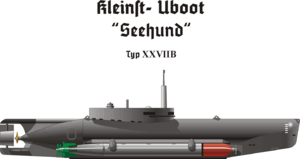 Type XXVII B 5 (Seehund) midget submarine | |
| Class overview | |
|---|---|
| Builders: | Germaniawerft, Kiel |
| Operators: | |
| Built: | 1944–1945 |
| In commission: | 1944–1945 |
| Planned: | 1,000 |
| Completed: | 285 |
| Active: | 138 |
| Lost: | 35 |
| General characteristics | |
| Displacement: | 17 long tons (17 t) submerged |
| Length: | 12 m (39 ft) |
| Beam: | 1.5 m (4.9 ft) |
| Propulsion: | |
| Speed: |
|
| Range: |
|
| Complement: | 2 |
| Armament: | 2 G7e torpedoes |
The Seehund (German: "seal"), also known as Type XXVII, was a successful series of German midget submarines created during World War II. Designed in 1944, and operated by two-man crews, the submarines were used by the Kriegsmarine during the closing months of the war, sinking nine merchant vessels and damaging an additional three, with 35 losses mostly attributed to bad weather.
History
The origin of the Seehund began with the salvage of the two British X class submarines HMS X6 and X7 which had been sunk during Operation Source, an attempt to sink the German battleship Tirpitz. Hauptamt Kriegschiffbau subsequently produced a design for a two-man submarine based on inspection of the British boats, designated Type XXVIIA and named Hecht ("Pike")Crew 327
XXVIIA (Hecht)
Like the British X class boats, the Type XXVIIA was designed to carry explosive charges to be laid beneath enemy ships, but it was markedly smaller and had substantial differences from the X class. It dispensed with a dual diesel/electric propulsion system, relying instead solely on electrical power in the form of a 12 hp AEG torpedo motor, on the basis that since it would operate submerged there was no need for a diesel engine. However, this resulted in a very low endurance of 69 nmi (128 km; 79 mi) at 4 knots (7.4 km/h; 4.6 mph).
Since the boat would need to be able to pass through anti-submarine nets and similar obstacles, it was designed without hydroplanes or fins, her trim being controlled with adjustable weights within the pressure hull. In practice this proved totally ineffective since the weights could not be moved quickly enough and hydroplanes and fins were subsequently fitted. Submerged control was still poor, since Hecht was not fitted with ballast tanks.
Even though Hecht had been designed to transport an explosive charge, Karl Dönitz insisted that a torpedo be carried so that attacks could be carried out on vessels in coastal waters.
Externally, Hecht resembled the British Welman submarine. The detachable explosive charge was fitted to the nose of the submarine, while the forward section held the battery and a gyrocompass, the first to be fitted to a German midget submarine and considered essential for navigation if the craft was to operate submerged. Behind this was the control compartment with seats for the two-man crew arranged one behind the other on the centerline with the engineer in front and the commander behind him. The commander was provided with a periscope and a clear acrylic dome for navigational purposes.
On 18 January 1944, Dönitz discussed the new design with Adolf Hitler who expressed his approval, and on 9 March contracts were placed with Germaniawerft of Kiel for construction of a prototype, followed by a further contract for 52 submarines on 28 March.
The 53 Hechts were constructed between May and August 1944: in the event, none saw active service but were instead used to train Seehund crews.
Type XXVIIB
As the orders were being placed, Hecht variants were under construction. The first was the Type XXVIIB, which had a greater range, could carry two G7e torpedoes, and had diesel/electric propulsion. The design was completed at the end of June 1944 and resembled Hecht but had a better boat-shaped external casing for improved seakeeping while surfaced, and saddle tanks. Additional room had been made inside the pressure hull by moving the batteries to the keel, while the two torpedoes were slung externally in recesses in the lower hull. A 22 hp diesel engine was fitted for surface use and was estimated to give a surfaced speed of 5.5 knots (10.2 km/h; 6.3 mph), with a 25 hp electric motor providing a submerged speed of 6.9 knots (12.8 km/h; 7.9 mph).
The final variant of the Type XXVII was the Type XXVIIB5, better known as the Seehund ("Seal") or Type 127. Seehund had a small raised platform midships with the air intake mast, magnetic compass, periscope, and a clear dome which could survive depths of 45 m (148 ft). The submarine's fixed 3 m (9.8 ft) periscope incorporated lenses which let the commander check the sky above for aircraft before surfacing.
Production
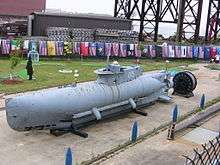
The first contract for Seehund construction was placed on 30 July 1944. Enthusiasm for the submarine was so high that most of the contracts and hull numbers were allocated even before the design was completed. A total of 1,000 boats were ordered, Germaniawerft and Schichau-Werke to build 25 and 45 boats per month respectively. Other centers involved in Seehund production were CRD-Monfalcone on the Adriatic and Klöckner-Humboldt-Deutz at Ulm.
However, Dönitz would not consent to the production of the Type XXVIIA being held up for Seehund construction, while shortages of raw material, labor and transport problems, and conflicting priorities in Germany's economy all combined to reduce Seehund production. In the end Seehund production was undertaken by Germaniawerft at Kiel using a facility which was no longer needed for Type XXI or Type XXIII production.
A total of 285 Seehunds were constructed and allocated numbers in the range U-5501 to U-6442.
Operational service
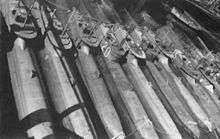
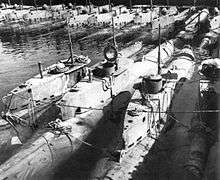
The first Seehund operation took place on 31 December 1944, when 18 craft set out from IJmuiden in the Netherlands. However this was a disaster - the submarines encountered a storm and only two returned. The first sinking by a Seehund did not occur until February 1945 when a freighter was sunk off Great Yarmouth.[1]
Seehunds operated mainly around the German coast and in the English Channel, and could attack on the surface in turbulent weather, but had to be almost stationary for submerged attacks. From January to April 1945 Seehunds performed 142 sorties, and accounted for about 93,000 gross tons of shipping (British sources estimate 120,000 tons).[2]
From the Allied point of view the Seehund's small size made it almost impossible for Asdic to get a return from her hull, while her very quiet slow speed running made her almost immune to detection by hydrophone. As Admiral Sir Charles Little, Commander-in-Chief, Portsmouth put it, "Fortunately for us these damn things arrived too late in the war to do any damage".
The last Seehund sorties took place on 28 April and 2 May 1945, when two special missions were performed to resupply the besieged German garrison at Dunkirk with rations. The boats carrying special food containers (nicknamed "butter torpedoes") instead of torpedoes, and on the return voyage using the containers to carry mail from the Dunkirk garrison.[3]
The French navy received four units as war reparations, and commissioned them as S 621, S 622, S 623 and S624. They were used until August 1953.
Survivors
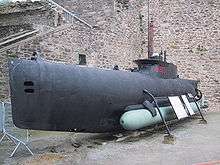
One of the boats used by the French navy post-war, S 622 is preserved and on display at the Musée national de la Marine in Brest, France.
The U-5075 is on display at the United States Naval Shipbuilding Museum, part of the Massachusetts Military Research Center, in Quincy, Massachusetts.[4] Occasional amateur radio events are conducted by this museum ship, using the callsign WW2MAN.
In Germany, Seehunds are displayed at several museums, the Technik Museum Speyer, the Deutsches Museum, Munich, the Marinemuseum Wilhelmshaven and the German Maritime Museum (Deutsches Schiffahrtsmuseum), Bremerhaven.
Notes
- ↑ Stille, Mark (20 June 2014). Axis Midget Submarines: 1939-45. Osprey Publishing. p. 27. ISBN 978-1-4728-0122-7.
- ↑ Blocksdorf, Helmut (2008). Hitler's Secret Commandos - Operations of the K-Verband. Great Britain: Pen & Sword Books, ltd. p. 135. ISBN 1-84115-783-X.
- ↑ Rohwer, Jürgen; Gerhard Hummelchen (1992). Chronology of the War at Sea 1939-1945. Naval Institute Press. p. 344. ISBN 1-55750-105-X.
- ↑ German SEEHUND (KU-5075)
References
- Rossler, Eberhard (2001). The U-Boat: The Evolution and Technical History of German Submarines. Cassell. ISBN 0-304-36120-8.
- Kemp, Paul (1999). Midget Submarines of the Second World War. Chatham Publishing. ISBN 1-86176-042-6.
- "Uboat.net". Information on the Seehund class and its operations. Retrieved July 16, 2006.
- "Historic Naval Ships Association: Seehund in Quincy, MA". Information on the Seehund class. Retrieved July 16, 2006.
- HNSA Ship Page: Seehund in Hackensack, NJ
External links
| Wikimedia Commons has media related to German Type XXVII submarines. |